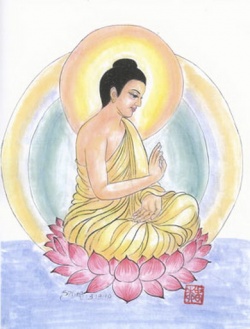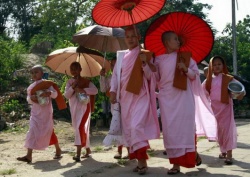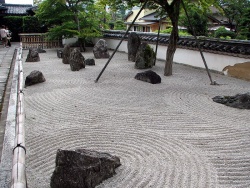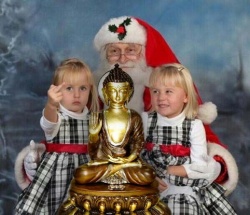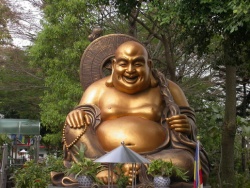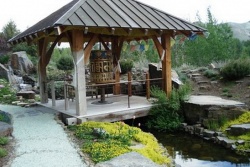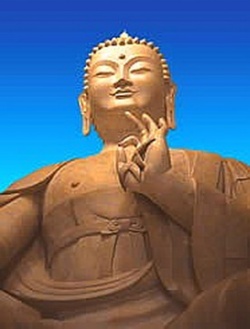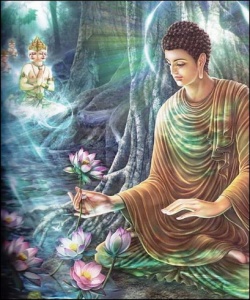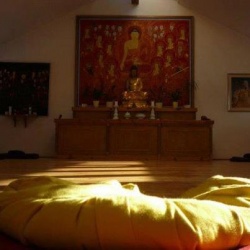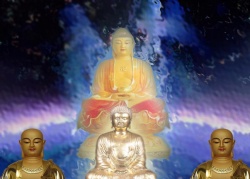Tantric and Esoteric Buddhism in Medieval Korea
Introduction
The goal of this paper is to present tantric elements and practices of Esoteric Buddhism in medieval Korea.
Throughout this work the reader will be exposed to a description of Esoteric Buddhism, tantras, also historic and religious context of Korea of middle ages.
Mainly the paper will present most important Korean figures of tantric teachings, elements of tantric nature (rituals, mandalas, deities visualisations, mantras, etc) and analyse various schools and sects of Esoteric Buddhism in Korea which emerged since 7th century , including Sinin, Chongji schools.
1. Tantric/Esoteric/Vajrayana Buddhism
Despite marginal differences between these three terms, for the sake of coherence of this paper, I will use them interchangeably.
Nevertheless, it is important to first give definitions and explain what exactly tantras and Esoteric Buddhism are so we could look for these aspects and elements in the context of Korean Buddhism.
More popularly known in the West as “Tantric Buddhism”, Esoteric Buddhism dates back to the mid-seventh century India.
It is characterized by its emphasis upon rituals, involving the use of mantras, mandalas, and other means in order to control both body and mind to experience the “ultimate” (Stanford 2006).
Therefore, the effect of rituals and practice is a key element in Esoteric Buddhism, resulting in complex and intricate variety of practices.
The term “Tantric” is used to denote a form of religious practice which is distinguishable from the rest of Buddhism principally by its ritual character.
The basic character of Tantric ritual is that it entails the evocation and worship of deities by means of mantras (Sanderson 1994:88).
Esoteric Buddhism was most successfully adopted in Tibet, imported by Padmasambhava. Vajrayana became the orthodox religion of Tibet and was partially influenced by local Bon tradition which resulted in a completely new form of Buddhism, dealing with visualisations of deities, rituals - overall, the most complex way to Enlightenment so far (Dargyay 1998:10).
2. First signs of Esoteric Buddhism in early-medieval Korea
For many scholars first signs of Esoteric Buddhism started to show in 7th century with such figures as Milbon and Hyetong (Sørensen et al. 2011: 576), (Payne 2006: 65).
In his work, Sørensen talks about Milbon, a monk appearing in the famous Buddhist tales Samguk yusa in which he is described as a thaumaturge who performed various acts of magic based on Esoteric Buddhism.
His miracles were mainly exorcistic in nature, in connection with which he is said to have used a magic wand (khakkara) and the recitation of Bhaiṣajyaguru sūtra.
Consequently, he has been considered one of the founders of the local Esoteric Buddhist tradition (Sørensen et al. 2011:576).
In his own book, Payne also talks about Milbon, describing one of stories seen in Samguk yusa. In this story Milbon, who was already widely known as a Dharma master, was invited to cure the Queen.
“Milbon stood outside the palace, recited Bhaiṣajyaguru sūtra, threw his wand with six rings into the queen’s chamber where it penetrated and old fox and Popchok;
he then threw them into the courtyard, whereupon the disease was cured. At that time there issued forth five-coloured spiritual rays from the top of Milbon’s head” (Payne 2006:66).
In same Samguk yusa there are stories about Hyet’ŏng and Myŏngnang, who is credited for conjuring up a storm which capsized the invading Chinese.
However, both Payne and Sørensen agree that there are no records of such people in Silla history scripts and the stories closely resemble stories of Vajrabodhi from China and at this point the historical development stops (Payne 2006:67) (Sørensen et al. 2011:578)
Stronger conclusions could be drawn from the archaeological findings in 7th to 8th centuries – found stupas suggested esoteric practices as it was confirmed later on: numerous reliefs found on stone stupas indicated the existence of cults worshipping “eight classes of divine beings”, the twelve spirits of the zodiac and vajrapālas (Sørensen et al. 2011:580).
Another significant evidence of tantric elements in Korean Buddhism are texts and commentaries: in his Kŭmgwang myŏngch’wi sŭngwang kyŏngsŏ Sŭngjang talks about tantric elements of dhāraṇī sutra which was practiced in kingdom of Silla towards the end of 7th century.
Also this text mentions Mahāmāyūrī-vidyarājnī sūtra, a major Esoteric Buddhism scripture, in its chapters on how to summon the twenty-eight classes of great rakṣa generals.
This reference, with its copious register of names of demons and spirits, could indicate that the beliefs and practices surrounding the invocations of various classes of demons for protection, as taught in this scripture, was in vogue among Korean Buddhists by the time Sŭngjang wrote his commentary (Sørensen et al. 2011:582).
Another significant text is Yaksa ponwŏn kyŏng kochŏk which features worship of the twelve spirit generals, each of which represents one of the animals in the zodiac; powerful spells; discussion of protection from various evil, including black magic (Sørensen et al. 2011:583).
3. Influence of Esoteric Buddhism on early Korean Sŏn Buddhism and the practice of Empowerement
After Unification of Silla, Sŏn Buddhism started to become popular and large numbers of Sŏn pilgrims migrated between Tang China and Korea in search of and enlightened master under whom to train (Sørensen 1988).
One of such kind was a monk named Hyeso who in his epitaph mentions pŏmpae chanting, used as a protection from wild animals - from the context we can assume that the secret methods referred to were various dhāraṇīs and mantras (Sørensen et al. 2011:589).
As Esoteric Budhism in Unified Silla became more and more prevalent, the trend of making stupas emerged.
The key word to this practice was “empowerment”, understood as a ritual method of invigorating and ordinary building, of infusing it with a divine power.
Monks also needed various objects of power, such as relics, and various holy items, such as images and Buddhist books.
One of such items was the woodblock print of a dhāraṇī sutra which was found in the Śākyamuni Stūpa in 1966 (Chang 2004: 264-265).
Due the power of the scripture, the maker of the stupa will be protected by a host of Buddhist divinities including the Four Heavenly Kings, Brahma, Indra, Maheśvara, yakṣas, etc.
This became an important example of the functioning of Esoteric Buddhism as a protector in Unified Silla (Sørensen et al. 2011:591).
4. Esoteric Buddhism tantric rituals under the Koryŏ
At the time when Kory dynasty started to rule Korea, Buddhism has already deeply rooted in, but only during this period did it flourish so much.
One of its thriving characteristics was that at this time there was quite a number of different Buddhist schools, two of which were tantric schools – Chongji sect of dhāraṇī (allegedly initiated by Hyet’ŏng) and Sinin (allegedly initiated by Myŏngnang) (Sang-Kyun Sun}} 1995:25 ).
However, both schools were short-lived.
In addition to the use of spells and ritual magic, a whole new range of Esoteric Buddhist rituals was introduced in the course of Koryŏ, including the rites dedicated to various wrathful divinities, the host of spirits and worship of the planets and constellations to prevent natural catastrophes.
Usually rain-stopping rituals were directed towards the dragon kings, supposedly dwelling in the ocean, lakes and rivers of the realm, and were held to be in charge of the natural forces that depended upon water as their main ingredient (Søensen et al. 2011:607).
Conclusion
After this general overview of Esoteric Buddhism development in medieval Korea it is clear that it was always there, participating in the formation of Korea’s cultural and religious identity.
This paper described how tantric practices slowly integrated into the orthodox religion and thrived throughout centuries.
However, because of the limits and formal restrictions of this work the topic ends at an early point – Esoteric Buddhism in Korea is prominent throughout further centuries, resulting in more sects and schools (e.g. Jingak), etc.
Nevertheless, the study of Esoteric Buddhism in Korea is still young, there are not many sources and the data is limited, thus there is a lot of room for new discoveries and new conclusions to be made about the tantras’ impact upon Korean Buddhism.
Bibliography
Chang Ch‘ungsik 2004. Han’guk pulgyo misul yŏn’gu 한국불교미술연구. Seoul: Sigonart.
[[Dargyay, Eva Maria[[. The Rise of Esoteric Buddhism in Tibet. Delhi: Motilal Banarsidass, 1998.
Krummel, John, "Kûkai", The Stanford Encyclopedia of Philosophy (Spring 2014 Edition), Edward N. Zalta (ed.), URL = <http://plato.stanford.edu/archives/spr2014/entries/kukai/>.
Payne, Richard Karl. Tantric Buddhism in East Asia. Boston: Wisdom Publications, 2006.
Sanderson, Alexis. “Vajrayāna: Origin and Function.” In:Buddhism into the Year 2000. International Conference Proceedings, Bangkok and Los Angeles: Dhammakāya Foundation (1995), pp. 89-102.
Sørensen, Henrik H. , Charles D. Orzech, and Richard K. Payne. "Esoteric Buddhism in Korea ." In Esoteric Buddhism and the Tantras in East Asia. Boston: Brill, 2011
Sun , Sang-Kyun. "A Brief Historical Introduction of the Esoteric Buddhism in Korea." Bulletin of Tibetology 31: 25-26.
